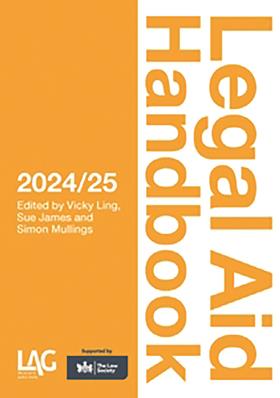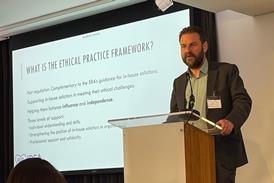Legal Aid Handbook 2024/25
Edited by Vicky Ling, Sue James and Simon Mullings
£85, Legal Action Group
★★★★★
I was delighted to be asked to review the latest edition of the Legal Aid Handbook. There is no more challenging time to be a legal aid lawyer. Legal aid matters and yet has been in crisis for years, if not decades. Without a real increase in funding, it will cease to exist. Skilled practitioners are now reaching retirement age, but recruitment is difficult. So, hats off to those determined lawyers who are still acting for ordinary people, often in unpopular areas of practice.
This book is essential. Specialist contributors set out clearly what needs to be done to ensure that clients can get redress and, most importantly, that the busy lawyer at the coalface of practice can be paid for the work they do.
There are 13 contributors to the book, all of whom have extensive experience of legal aid work, with most having built highly successful careers as legal aid lawyers. One of the editors, Vicky Ling, worked for the Legal Aid Board in the early 1990s and has unparalleled knowledge of the sector. All the contributors have provided chapters based on their specialism. This is useful as criminal legal aid differs from civil. Correct application forms have to be completed for different practice areas, a process that may be obvious to ‘old hands’ but less so to the new practitioner. An error with the application can often prove fatal. In the worst-case scenario, the work done is not covered and the firm has incurred expenses which cannot be reclaimed but will have to be met by the firm.
The section ‘Legal aid: what you need to know at a glance’ is indispensable. Here, Sue James and Simon Mullings set out a comprehensive and highly readable summary of what a legal aid lawyer needs to know about the system. The central issues of eligibility and scope are covered for both crime and civil legal aid. CCMS (client costs management system) has a chapter of its own but there is a handy summary here in this section.

The book is set out in three parts. Part A encompasses 17 chapters, covering the various practice areas where legal aid is available: family law, crime, housing, immigration, mental health and others. Presentation is clear with a useful table of key resources and points to note.
There is also an extremely helpful chapter on exceptional case funding (ECF). This was intended to be a safety net after the Legal Aid, Sentencing and Punishment of Offenders Act 2012, though ECF proved to be anything but. ECF is designed to cover cases where representation is needed but which do not fall into the categories of cases which attract public funding. Chapters 14, 15, 16 and 17 cover getting paid for various contract areas as well as any appeals, setting out all the essential aspects of what needs to be done.
Part B covers legal aid advocacy in civil, family and criminal. This work is paid separately, often to barristers, though under the legal aid certificate held by the firm. The practitioner needs to be alive to what is covered, and to the effect that advocacy has on the costs limit of any certificate, so that timely costs extensions can be applied for.
Part C covers managing a legal aid contract. This is important reading for anyone undertaking legal aid – the effect of any errors can be significant. The key performance indicators which the Legal Aid Agency requires are set out – and should be regularly monitored by someone who fully understands how legal aid works. This section is the one with which any managing partner or financial director should be fully familiar, whether they personally undertake legally aided work or not.
The clear division of the book covering separate areas of practice is useful, given that different funding applies to different areas. Workers undertaking case management are often paralegals or trainees and usually have first contact with new clients. They need to ensure that they collect the correct information when applying for legal aid. Errors that occur at an early stage can prove costly later, in terms of both financial loss to the firm, for work done outside the scope of any legal aid certificate, and in respect of client satisfaction, if the client has to change solicitors as a result.
In addition, each chapter sets out how to conduct a case for the different specialisms – again helpful if the firm has a number of practice areas.
I cannot recommend this book highly enough. It is clear, concise and comprehensive. It is exactly what the busy legal aid practitioner, whether a sole practitioner or running a large firm, needs to ensure that they can understand what can seem at times a scheme of byzantine complexity.
Charlotte Collier is a consultant solicitor at Taylor-Rose MW Solicitors































No comments yet